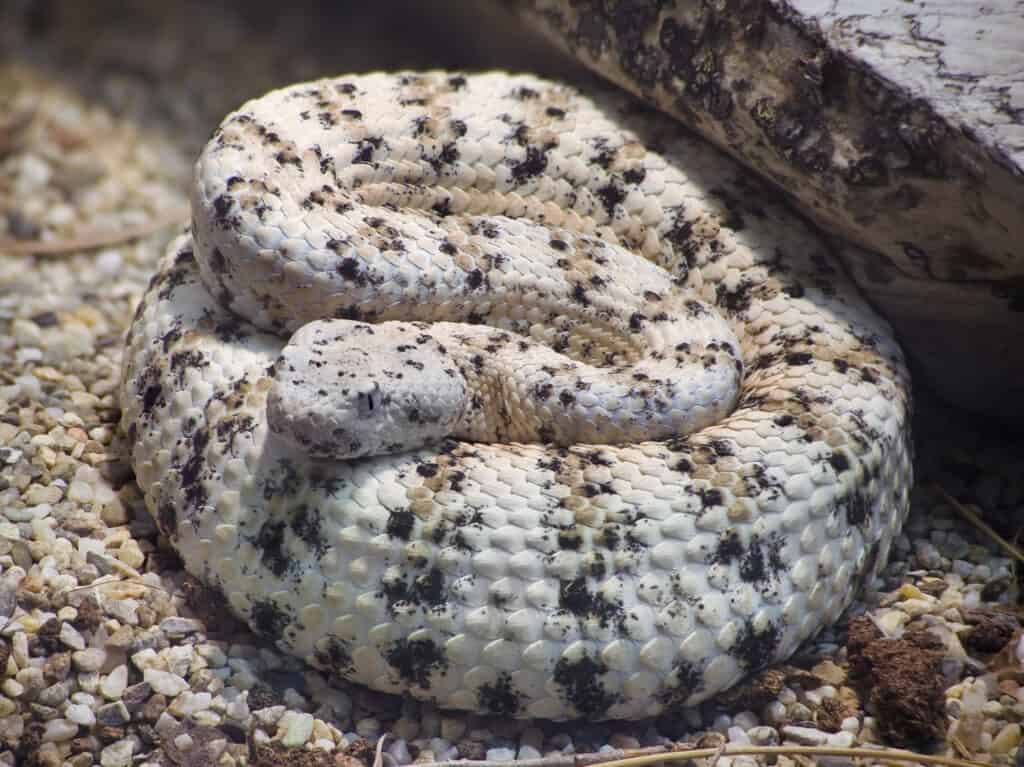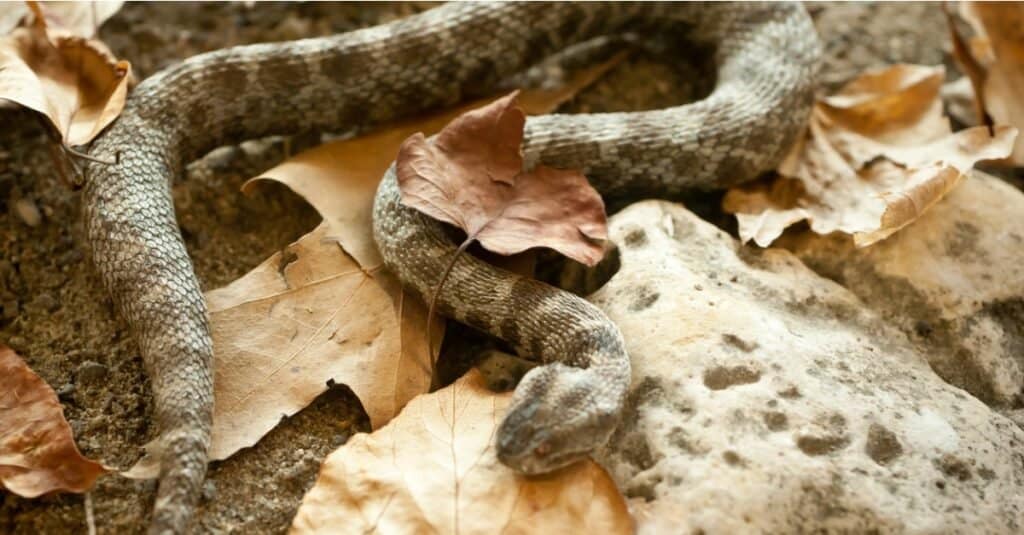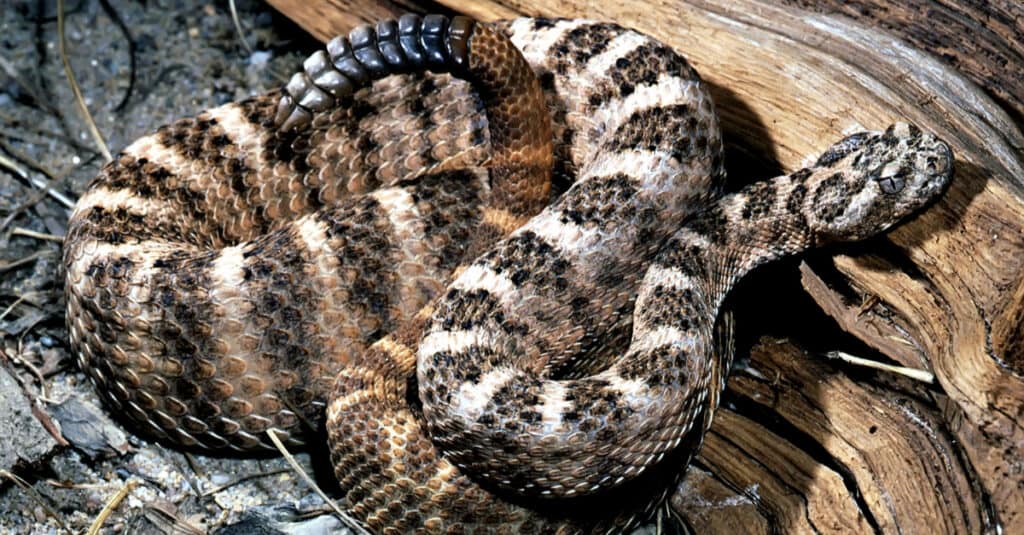In part, thanks to its dry, arid climate, Arizona has more rattlesnakes than any other US state! In fact, around 15 species of these fearsome serpents can be found in the Grand Canyon State. Whether you live there or just plan on visiting, it’s worth knowing what kinds of rattlesnakes live in Arizona, as well as when they’re most active, some interesting facts about them, and where you might find them (or, if you’re an ophidiophobe, where to avoid them at all costs). Let’s take an in-depth look below!
What Kinds of Rattlesnakes Live in Arizona?

Arizona rattlesnakes include the speckled rattlesnake and 14 other species.
©Dario Sabljak/Shutterstock.com
Like we briefly touched on above, Arizona is something of a haven for rattlesnakes in particular. This is mainly due to its hot, dry climate and abundant desert habitats like the Mojave, Sonoran, Great Basin, and Chihuahuan. It’s actually the only US state with four deserts, and though these environments are harsh and uninviting to us humans, they’re ideal for rattlesnakes, which thrive in hot, low-humidity conditions.
In total, a whopping 15 varieties of rattlesnakes live in Arizona:
- Western Diamondback Rattlesnake, Crotalus atrox
- Mojave Green Rattlesnake, Crotalus scutulatus
- Speckled Rattlesnake, Crotalus mitchellii
- Sidewinder Rattlesnake, Crotalus cerastes
- Massasauga Rattlesnake, Sistrurus catenatus
- Banded Rock Rattlesnake, Crotalus lepidus klauberi
- Great Basin Rattlesnake, Crotalus oreganus lutosus
- Grand Canyon Rattlesnake, Crotalus oreganus abyssus
- Prairie Rattlesnake, Crotalus viridis
- Twin Spotted Rattlesnake, Crotalus pricei
- Tiger Rattlesnake, Crotalus tigris
- Arizona Black Rattlesnake, Crotalus cerberus
- Northern Black-Tailed Rattlesnake, Crotalus molossus molossus
- Arizona Ridge-Nosed Rattlesnake, Crotalus willardi
- New Mexico Ridge-Nosed Rattlesnake, Crotalus willardi obscurus
Interesting Facts About Arizona’s Rattlesnakes

Arizona rattlesnakes include the Massasaugas rattlesnake, even though it’s much smaller than a typical rattler.
©iStock.com/Westhoff
As you can see, nearly all 15 of Arizona’s rattlesnake species fall under the Crotalus or Sistrurus genera. While the majority of rattlesnakes, in general, are classified within Crotalus, the Massasauga rattlesnake is a bit of an outlier for a few reasons.
For starters, Massasaugas are much smaller than typical rattlers. Their scalation also differs, as rather than having a head covered in lots of small scales like Crotalus rattlesnakes, Massasaugas have exactly nine large head plate scales. Finally, Massasaugas have a more high-pitched rattle due to their smaller size than the rattles of Crotalus species. Regardless, they are still technically rattlesnakes, and they’re still venomous and can be dangerous if approached or startled.
Arizona’s most common rattlesnakes of this group are the western diamondback and Mojave green, which can be found throughout much of the state, particularly in the more remote reaches of its four deserts. The black-tailed species is also very common, with its geographic range covering most of the state’s southern half.
The largest rattlesnake of this group residing in Arizona is the western diamondback species. It can grow to six feet in length and weigh more than 10 pounds when fully grown! It’s also one of the more aggressive varieties responsible for most snake bites in the state. The most venomous species, however, is the Mojave green, which can also be highly aggressive when provoked but tends to be a bit more reclusive than the western diamondback.
While these species vary significantly in size, behavior, color, and appearance, they are all highly venomous and can inflict incredibly painful bites. Fortunately, although around 150 people in Arizona are unlucky enough to be bitten by a rattlesnake each year, deaths are extremely rare.
When and Where Are Arizona’s Rattlesnakes Most Active?

Arizona rattlesnake season is from March through November.
©Vladislav T. Jirousek/Shutterstock.com
Now that we understand what kinds of rattlesnakes live in Arizona, let’s get into when and where they tend to be most active. Most Arizona natives define “Rattlesnake season” in the state as March through November. Additionally, rattlesnakes are generally diurnal, so they are active during the day and tend to rest at night. But why are they most active only during such a particular time of year?
Although snakes don’t technically hibernate, they enter a much lower activity period during the year’s colder months. This semi-hibernation state, brumation, involves a lot of sleeping, eating less, and conserving energy in general while temperatures are lower than usual. As cold-blooded animals, rattlesnakes rely on external heat to keep their bodies warm and active. Without constant heat, they must expend much less energy to survive until temperatures rise again in the spring.
When it comes to where rattlesnakes tend to frequent, things get a bit more complicated. While most varieties of rattlers tend to prefer dry, sandy, or rocky outcrops with sparse vegetation in more remote regions, many of them like the western diamondback, are sort of habitat generalists. This means they can actually thrive in a wide range of habitats.
On the bright side, though, most varieties of rattlesnakes tend to avoid humans and wide, open spaces. In general, if you stay alert and keep your distance, most rattlers will also give you a wide berth, even in states like Arizona, where they are very abundant.
The photo featured at the top of this post is © iStock.com/Westhoff
Discover the "Monster" Snake 5X Bigger than an Anaconda
Every day A-Z Animals sends out some of the most incredible facts in the world from our free newsletter. Want to discover the 10 most beautiful snakes in the world, a "snake island" where you're never more than 3 feet from danger, or a "monster" snake 5X larger than an anaconda? Then sign up right now and you'll start receiving our daily newsletter absolutely free.
Thank you for reading! Have some feedback for us? Contact the AZ Animals editorial team.







